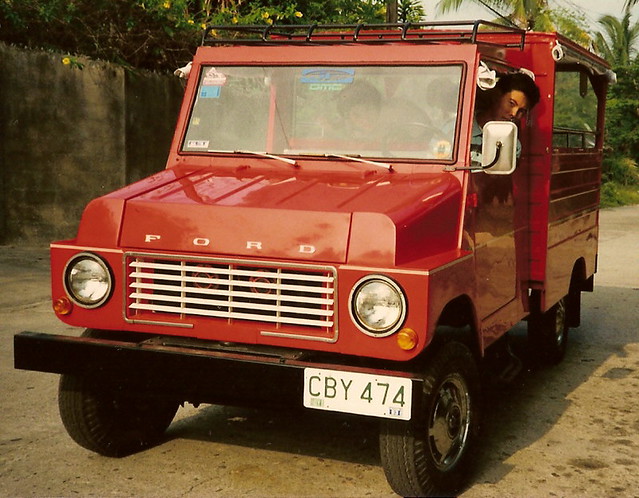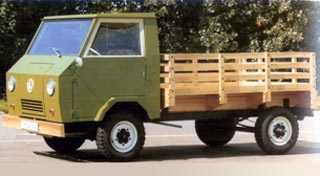It was during the Marcos period from the late 70's to the 80's that the AUV's of all shapes and sizes were born, here's a brief story of the short but colorful Philippine automotive industry
Gathering all the car assemblers into one fold and offering tax incentives and generous governmental incentives, the Philippines pushed for the first People’s Car during the reign of Ferdinand Marcos. The car assemblers responded and formed the Progressive Car Manufacturers Association of the Philippines. Under the program, each car assembler would contribute a part for all assemblers to use in one of their models. Delta Motors, the assembler of Toyota cars and SUV was to manufacture the 1600 4-cylinder gas engine. CARCO, the Yulo firm that assembled Mitsubishi cars, was to contribute a 5-speed manual transmission. Ford Philippines was to machine stamp all body parts in their Morong, Bataan Plant while GM Pilipinas, assembler of Isuzu pick up and Chevrolet/Opel/Holden cars was to manufacture the rear differential.
Delta went on to manufacture the engine block for the Toyota 12-R 1600 4-cylinder gas engine and CARCO started producing transmission for the box type Lancer. Ford Phils. for its part began machine stamping body parts for the Mazda 323 and Mazda 626. GM Pilipinas chose to import a rear differential. But the much-ballyhooed People’s Car did not come into fruition after the fact.
For one, Mitsubishi Motors of Japan began to phase out the rear-wheel drive Lancer and started manufacturing the cheaper front-wheel drive model. The Mazda 323 and 626 to begin with, were also front-wheel drive so only the Toyota Corona, Delta Motor’s entry into the People’s Car Initiative, would have benefited from the cooperation had they pushed through with the program.
Secondly, the economics of scale just wasn’t there. The Philippines could buy cars in a year what other nations could, in less than three to four months.
So, the assemblers, now manufacturers, approached Japan for technical help in transitioning to the front-wheel drive in order to penetrate the global market. Japan, for its part, was rather lukewarm to the idea. And for obvious reasons. Next, the manufacturers banded together with other regional emerging car manufacturers like Malaysia and approached South Korea for help. Again they got no more than a tepid response. And then the Philippines collapsed.
Meanwhile, Malaysia armed with the blue print of the proposed regional People’s Car went ahead and manufactured the Proton. South Korea’s Daewoo, Kia and Hyundai launched their global assault.
It did so while waiting for progress on the People’s Car Initiative. The powerplant they used was the Toyota 12-R 1600 gas engine with locally manufactured engine block. The rest of the powertrain was imported from Chrysler-DANA of Canada. Wiring harness and gauges were manufactured by Yazaki-Torres of Laguna while lights were from Yankee Turnflex Philippines. The Toyota Corona 4-door sedan also used the locally produced 12-R engine.
Ford Phils. packed up and left shortly after the collapse of the Philippine economy when they could not move any of their 323 and 626 models as quickly as they wished. They moved their manufacturing facility somewhere else. GM moved away too.
The Filipino AUV
As an offshoot of the People’s Car initiative, the car manufacturer’s also came up with the AUV idea. Ford Phils. was first with its Ford Fiera.
This was the AUV that had the biggest gas engine displacement in its time. It was powered by a Mitsubishi 1800 4-cylinder gas engine. While powerful, it suffered among the Filipino buyers since it had the most dismal gas mileage. Something like 7 kilometers to a liter.
This particular example must have figured in a front-end collision since it no longer has its original headlamps. The original headlamps were tandem sealed beams.
This one has a single circular sealed beam with a modified crown to make the headlamp appear rectangular. A common trick among Philippine jeepneys.
Francisco Motors later introduced the bigger Pinoy II with an Isuzu C-190 diesel engine. The same engine as its Francisco Jeepney used, the only jeepney manufactured in the Philippines with a brand-new engine in its time. GM Pilipinas retired Harabas and introduced a bigger Isuzu pick up based AUV with a C-190 engine also.
After all the manufacturers left the Phils. except for Mitsubishi CARCO, backyard body shops continued to manufacture AUV based on the last Ford Fiera XLT model.
Bacolod City, officially the City of Bacolod (Filipino: Lungsod ng Bacólod), is a highly urbanized midsize Philippine city. It is the capital of theprovince of Negros Occidental. Having a total of 499,497 inhabitants as of August 1, 2007, it is the most populous city in the Western Visayas Region. It is currently ranked as the 17th most populous city in the Philippines. It is notable for its world famous MassKara Festival held during the 3rd week of October. Known for being a relatively friendly city, it bears the nicknames "City of Smiles"
Bacólod (English: Bacolod), is derived from bakólod (Old Spelling: bacólod), the Old Hiligaynon or Old Ilonggo (Old Spelling: Ylongo and Ilongo) word for a "hill, mound, rise, hillock, down, any small eminence or elevation", since the resettlement was founded on a stony, hilly area, now the barangayof Granada. It was officially called Ciudad de Bacólod (English: City of Bacolod) when Municipalidad de Bacólod (English: Municipality of Bacolod) was converted into a city in 1938.
As an offshoot of the People’s Car initiative, the car manufacturer’s also came up with the AUV idea. Ford Phils. was first with its Ford Fiera.
 |
| A heavily Modified 2nd generation Ford Fiera |
At its peak, you cannot miss a Fiera at any major intersection anywhere in the Phils. It was truly a People’s Car. Utilitarian, spartan, brand new and dirt cheap. Following its success,
GM Pilipinas followed suit with its GM Harabas.
Francisco Motors introduced the first-generation Pinoy. Not one to be left out,
Mitsubishi motors also got into the AUV game with the Cimmaron
This particular example must have figured in a front-end collision since it no longer has its original headlamps. The original headlamps were tandem sealed beams.
This one has a single circular sealed beam with a modified crown to make the headlamp appear rectangular. A common trick among Philippine jeepneys.
Delta Motors introduced the Toyota Tamaraw.
Even Volkswagen joined the fray with its Trakbayan. the Trakbayan was made in the Philippines. Trak (Filipino), means truck and bayan (Filipino) means, country; hence the term Trakbayan (country-truck). These were under the supervision of DMG, the official VW dealer in the Philippines.
Francisco Motors later introduced the bigger Pinoy II with an Isuzu C-190 diesel engine. The same engine as its Francisco Jeepney used, the only jeepney manufactured in the Philippines with a brand-new engine in its time. GM Pilipinas retired Harabas and introduced a bigger Isuzu pick up based AUV with a C-190 engine also.
Ford Phils. followed up its successful Fiera with the Ford Fiera XLT line up. The line up was powered by a Mazda diesel engine with a 5-speed transmission. They were the sexiest among all the AUV during their prime. All the AUV in the Phils. now derived their basic design from the Ford Fiera XLT. Interestingly, later models of the Ford Fiera XLT used brand new Isuzu C-230 diesel engine manufactured by Isuzu Phils. as part of the Progressive Truck Manufacturers Association of the Philippines truck program.
After all the manufacturers left the Phils. except for Mitsubishi CARCO, backyard body shops continued to manufacture AUV based on the last Ford Fiera XLT model.
Bacolod and its jeeps
Bacólod (English: Bacolod), is derived from bakólod (Old Spelling: bacólod), the Old Hiligaynon or Old Ilonggo (Old Spelling: Ylongo and Ilongo) word for a "hill, mound, rise, hillock, down, any small eminence or elevation", since the resettlement was founded on a stony, hilly area, now the barangayof Granada. It was officially called Ciudad de Bacólod (English: City of Bacolod) when Municipalidad de Bacólod (English: Municipality of Bacolod) was converted into a city in 1938.
Bacolod has a total land area of 16,145 hectares, including straits and bodies of water and the 124 hectare reclamation area; and is composed of 61 barangay (villages) and 639 purok (smaller units composing a village). It is accessible by sea through the ports of Banago; the BREDCO Port in the Reclamation Area, and the port of Pulupandan. By air, it is accessible through the New Bacolod-Silay International Airport, which is approximately 13 (four is counting from the Lagoon) kilometers away from the center of the city.
Bacolod is ideally located on a level area, slightly sloping as it extends toward the sea with an average slope of 0.9 percent for the city proper and between 3 to 5 percent for the suburbs. The altitude is 32.8 feet or 10.0 meters above sea level with the Bacolod City Public Plaza as thebenchmark. Bacolod has two pronounced seasons, wet and dry. The rainy season starts from May to January of the following year with heavy rains occurring during the months of August and September. Dry season starts from the month of February until the last week of April.
not long after, local fabricators such as M-celeste, Cebro, Chariot, Aljin and Joshbianc Motors together with other local shops in the late 90's to the early 2000's started to build jeeps based on enlarged fiera models and was equipped with married components from different truck manufacturers, which now forms one of the most vital vehicles in the Negros Occidental inter-municipal routes..
Jeeps in Bacolod are a true icon of Filipino ingenuity, that's why illongos here in Bacolod ride the bacolod jeep proudly..

















